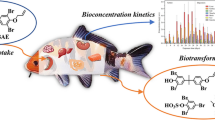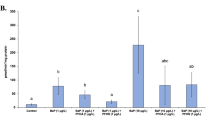Abstract
In the aquatic environment, biotransformation enzymes are established biomarkers for assessing PAH exposure in fish, but little is known about the effect of 17β-estradiol (E2) on these enzymes during exposure to benzo(a)pyrene (BaP). In this study, Nile tilapia (Oreochromis niloticus) were exposed for 3, 5, and 10 days to BaP (300 μg L−1) and E2 (5 μg L−1). These substances were applied isolated or mixed. In the mixture experiment, fish were analyzed pre- and postexposure in order to better understand whether preexposure to the hormone masks the responses activated by PAH or vice versa. Phase I enzymes ethoxyresorufin-O-deethylase (EROD), pentoxyresorufin-O-depenthylase (PROD), and benzyloxyresorufin-O-debenzylase (BROD) activities as well as the phase II enzyme glutathione S-transferase (GST) were analyzed. Isolated E2 treatment decreased EROD activity after 3 days, but this enzyme activity returned to control values after 5 and 10 days of exposure. Isolated BaP treatment significantly induced EROD activity after 3 and 5 days, and the activity returned to control levels after ten exposure days. Combined treatment (E2 + Bap) significantly increased EROD activity, both in the pre- and postexposure. This increase was even higher than in the isolated BaP treatment, suggesting a synergism between these two compounds. When E2 and BaP were used singly, they did not change BROD and PROD activities. However, combined treatment (E2 + Bap) significantly increased PROD activity. Isolated BaP treatment increased GST activity after 10 days. However, this response was not observed in the mixture treatment, suggesting that E2 suppressed the GST induction modulated by BaP. The results put together indicated that E2 altered the biotransformation pathway regarding enzymes activated by BaP in Nile tilapia.





Similar content being viewed by others
References
Ahmad I, Maria VL, Pacheco M, Santos MA (2009) Juvenile sea bass (Dicentrarchus labrax L.) enzymatic and non-enzymatic antioxidant responses following 17beta-estradiol exposure. Ecotoxicol 18:974–982
Arukwe A, Nordtug T, Kortner TM, Mortensen AS, Brakstad OG (2008) Modulation of steroidogenesis and xenobiotic biotransformation responses in zebrafish (Danio rerio) exposed to water-soluble fraction of crude oil. Environ Res 107:362–370
Bozcaarmutlu A, Arinç E (2008) Purification of CYP2B-like protein from feral leaping mullet (Liza saliens) liver microsomes and its biocatalytic, molecular, and immunological characterization. J Biochem Mol Toxicol 22:284–98
Bradford MM (1976) A rapid and sensitive method for the quantitation of microgram quantities of protein utilizing the principle of protein-dye binding. Anal Biochem 7:248–254
Burke MD, Mayer RT (1985) Ethoxy-, pentoxy- and benzylloxyphenones ans homologues: a series of substrates to distinguish between different induced cytochrome P-450. Biochem Pharmacol 34:33–37
Carrera EP, García-López A, Martín del Río Mdel P, Martínez-Rodríguez G, Solé M, Mancera JM (2007) Effects of 17beta-estradiol and 4-nonylphenol on osmoregulation and hepatic enzymes in gilthead sea bream (Sparus auratus). Comp Biochem Physiol C Toxicol Pharmacol 145:210–217
Chan C-R, Lee D-N, Cheen Y-H, Hsieh DJ-Y, Weng C-F (2008) Feed deprivation and re-feeding on alterations of proteases in tilapia Oreochromis mossambicus. Zool Stud 47(2):207–214
Gagnaire B, Geffard O, Noury P, Garric J (2010) In vivo indirect measurement of cytochrome P450-associated activities in freshwater gastropod molluscs. Environ Toxicol 25:545–53
González JF, Reimschuessel R, Shaikh B, Kane AS (2009) Kinetics of hepatic phase I and II biotransformation reactions in eight finfish species. Mar Environ Res 67:183–188
Gräns J, Wassmur B, Celander MC (2010) One-way inhibiting cross-talk between arylhydrocarbon receptor (AhR) and estrogen receptor (ER) signaling in primary cultures of rainbow trout hepatocytes. Aquat Toxicol 100(3):263–270
Hughes EM, Gallagher EP (2004) Effects of 17-beta estradiol and 4-nonylphenol on phase II electrophilic detoxification pathways in largemouth bass (Micropterus salmoides) liver. Comp Biochem Physiol C Toxicol Pharmacol 137:237–47
Indra R, Moserova M, Sulc M, Frei E, Stiborova M (2013) Oxidation of carcinogenic benzo[a]pyrene by human and rat cytochrome P450 1A1 and its influencing by cytochrome b5—a comparative study. Neuro Endocrinol Lett 34:55–63
Jana NR, Sarkar S, Ishizuka M, Yonemoto J, Tohyama C, Sone H (2000) Comparative effects of 2,3,7,8-tetrachlorodibenzo-p-dioxin on MCF-7, RL95-2, and LNCaP cells: role of target steroid hormones in cellular responsiveness to CYP1A1 induction. Mol Cell Biol Res Commun 4:174–80
Keen JH, Habig WH, Jakoby WB (1976) Mechanism for the several activities of the glutathione S-transferases. J Biol Chem 251:6183–6188
Lemaire P, Livingstone DR (1993) Pro-oxidant/antioxidant processes and organic xenobiotics interactions marine organisms, in particular the flounder Platichthys flesus and the mussel Mytilus edulis. Trends Comp Biochem Physiol 1:1119–1150
Matthews J, Gustafsson JA (2006) Estrogen receptor and aryl hydrocarbon receptor signaling pathways. Nucl Recept Signal 4:e016
Miao J, Pan L, Liu N, Xu C, Zhang L (2011) Molecular cloning of CYP4 and GSTpi homologues in the scallop Chlamys farreri and its expression in response to benzo[a]pyrene exposure. Mar Genomics 4:99–108
Nogueira L, Rodrigues ACF, Trídico CP, Fossa CE, de Almeida EA (2011) Oxidative stress in Nile tilapia (Oreochromis niloticus) and armored catfish (Pterygoplichthys anisitsi) exposed to diesel oil. Environ Monit Assess 180:243–255
Roa RL, Vicente HJ (2009) Compensatory weight gain and muscle tissue biochemical composition of GET Excel tilapia (Oreochromis niloticus) juveniles. J Environ Aquat Res 1(1):99–111
Sarkar S, Jana NR, Yonemoto J, Tohyama C, Sone H (2000) Estrogen enhances induction of cytochrome P-450 1A1 by 2,3,7,8-tetrachlorodibenzo-p-dioxin in liver of female Long-Evans rats. Int J Oncol 16:141–147
Sodré FF, Montagner CC, Locatelli MAF, Jardim WF (2007) Ocorrência de interferentes endócrinos e produtos farmacêuticos em águas superficiais da região de Campinas (SP, Brasil). J Braz Soc Ecotoxicol 2:187–196
Son DS, Roby KF, Rozman KK, Terranova PF (2002) Estradiol enhances and estriol inhibits the expression of CYP1A1 induced by 2,3,7,8-tetrachlorodibenzo-p-dioxin in a mouse ovarian cancer cell line. Aquat Toxicol 59:17–33
Spearow JL, Kota RS, Ostrach DJ (2011) Environmental contaminant effects on juvenile striped bass in the San Francisco Estuary, California. USA Environ Toxicol Chem 30:393–402
Stegeman JJ, Brower M, Di Giulio RT, Förlin L, Fowler BA, Sanders BM, Van Held PA (1992) Molecular responses to environmental contamination: enzyme and protein systems as indicators of chemical exposure and effect in biomarkers. In: Hugget RJ, Kimerle RA, Mehrle PP, Bergman HL (Eds), Biochemical, physiological, and histological markers of anthropogenic stress. Lewis, Chelsea, pp. 235–335
Teles M, Pacheco M, Santos MA (2005) Sparus aurata L. liver EROD and GST activities, plasma cortisol, lactate, glucose and erythrocytic nuclear anomalies following short-term exposure either to 17beta-estradiol (E2) or E2 combined with 4-nonylphenol. Sci Total Environ 336:57–69
Trídico CP, Rodrigues ACF, Nogueira L, da Silva DC, Moreira AB, de Almeida EA (2010) Biochemical biomarkers in Oreochromis niloticus exposed to mixtures of benzo[a]pyrene and diazinon. Ecotoxicol Environ Saf 73:858–863
Trisciani A, Corsi I, Torre CD, Perra G, Focardi S (2011) Hepatic biotransformation genes and enzymes and PAH metabolites in bile of common sole (Solea solea, Linnaeus, 1758) from an oil-contaminated site in the Mediterranean Sea: a field study. Mar Pollut Bull 62:806–814
Vaccaro E, Meucci V, Intorre L, Soldani G, di Bello D, Longo V, Gervasi PG, Pretti C (2005) Effects of 17β-estradiol, 4-nonylphenol and PCB 126 on the estrogenic activity and phase 1 and 2 biotransformation enzymes in male sea bass (Dicentrarchus labrax). Aquat Toxicol 75:293–305
Vieira LR, Sousa A, Frasco MF, Lima I, Morgado F, Guilhermino L (2008) Acute effects of benzo[a]pyrene, anthracene and a fuel oil on biomarkers of the common goby Pomatoschistus microps (Teleostei, Gobiidae). Sci Total Environ 395:87–100
Yan Z, Lu G, He J (2012) Reciprocal inhibiting interactive mechanism between the estrogen receptor and aryl hydrocarbon receptor signaling pathways in goldfish (Carassius auratus) exposed to 17β-estradiol and benzo[a]pyrene. Comp Biochem Physiol C Toxicol Pharmacol 156:17–23
Zamaratskaia G, Rasmussen MK, Herbin I, Ekstrand B, Zlabek V (2011) In vitro inhibition of porcine cytochrome P450 by 17β-estradiol and 17α-estradiol. Interdiscip Toxicol 4:78–84
Author information
Authors and Affiliations
Corresponding author
Additional information
Responsible editor: Markus Hecker
Electronic supplementary material
Below is the link to the electronic supplementary material.
ESM 1
(DOC 28 kb)
Rights and permissions
About this article
Cite this article
Rodrigues, A.C.F., de Oliveira Moneró, T., Frighetto, R.T.S. et al. E2 potentializes benzo(a)pyrene-induced hepatic cytochrome P450 enzyme activities in Nile tilapia at high concentrations. Environ Sci Pollut Res 22, 17367–17374 (2015). https://doi.org/10.1007/s11356-014-3670-5
Received:
Accepted:
Published:
Issue Date:
DOI: https://doi.org/10.1007/s11356-014-3670-5




